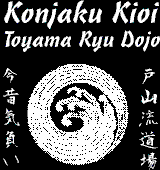|
Home
Hataya
Sensei DVD
Search
Bushido
Respect for Katana
Sword Dictionary
How to Guides
Bow In Ceremony
Warm Up Exercises
Bow Out Ceremony
Wearing Uniform
Formal Uniform
Wearing Daisho
Uniform Folding/Care
Katana Selection
Sword Dimensions
Sword Testing
Katana Maintenance
Katana Cleaning
Mekugi Replacement
Katana Disassembly
Is my sword sharp?
Edge Geometry
Surface Polish
Sharpening Guide
Training Basics
Kihon (Fundamentals)
8 Basic Cuts
Toyama Kata
Toyama Kukmitachi
Seitei Kata
Taikai Guides
Taikai Rules
Judging Guide
Tameshigiri
Target Prep & Spiking
Cutting Patters
Cutting Videos
Target Comparison
St Petersburg Dojo
Intro Letter
Femal Sensei
Dojo Members
Code of Conduct
Classes and Fees
Promotion Pictues
Rank Testing
Links

|
Fundamentals (Kihon) 基本
Sheathing (Chiburi / Nōtō) 血振り /納刀
Chiburi (flinging blood from the blade) and Nōtō
(sheathing the sword) must be performed while keeping focusing
attention on one's surroundings. This must be done with focus
and control.
- Start in Seigan no Kamae (standard guard stance)
- While performing the Chiburi, the left hand is
simultaneously dropped to the saya under the obi.
- The kissaki is rotated counter-clockwise until horizontal
and a sharp cutting motion is made to the right. This
motion is intended to shake and blood or debris from the blade.
- The kissaki should end directly in front of the right knee
at a height of mid thigh.
- The katana and right arm should be at the same angle.
- The right arm should be bent slightly.
- The left hand is slid up the saya making sure the kurikata
(sageo hook on saya) is outward.
- The left hand grasps saya a finger width above the koiguchi
(saya mouth).
- The katana is brought up to a horizontal position and
rotated around the body.
- The blade should be edge up when it is placed on the left
hand near the tsuba.
- The tsuka (handle) is pushed forward sliding the mune (back
of blade) on the left hand.
- The saya should be pulled back with the left hand while the
right hand pushes the katana forward.
- The saya is rotated to match the blade when the kissaki
(sword tip) reaches the koiguchi (saya mouth).
- The blade should be slid into the saya on the mune without
scraping the sides of the saya.
- When 3 ½ to 4 inches left of blade, the left foot should
come up at the same time to finish together.
- The thumb of the left hand is used to hold the tsuba to keep
the katana secure.
- The right hand should check the integrity of the tsuka by
moving to the kashira (pommel cap).
|

